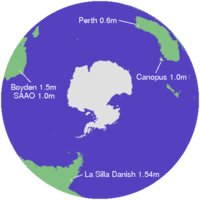
Probing Lensing Anomalies Network
Encyclopedia

Photometry (astronomy)
Photometry is a technique of astronomy concerned with measuring the flux, or intensity of an astronomical object's electromagnetic radiation...
measurements of the magnification of stars in the galactic bulge undergoing gravitational microlensing
Gravitational microlensing
Gravitational microlensing is an astronomical phenomenon due to the gravitational lens effect. It can be used to detect objects ranging from the mass of a planet to the mass of a star, regardless of the light they emit. Typically, astronomers can only detect bright objects that emit lots of light ...
by intervening foreground star
Star
A star is a massive, luminous sphere of plasma held together by gravity. At the end of its lifetime, a star can also contain a proportion of degenerate matter. The nearest star to Earth is the Sun, which is the source of most of the energy on Earth...
s (or other compact massive objects). This network consists
of five 1m-class optical telescope
Optical telescope
An optical telescope is a telescope which is used to gather and focus light mainly from the visible part of the electromagnetic spectrum for directly viewing a magnified image for making a photograph, or collecting data through electronic image sensors....
s distributed in longitude
Longitude
Longitude is a geographic coordinate that specifies the east-west position of a point on the Earth's surface. It is an angular measurement, usually expressed in degrees, minutes and seconds, and denoted by the Greek letter lambda ....
around the southern hemisphere
Southern Hemisphere
The Southern Hemisphere is the part of Earth that lies south of the equator. The word hemisphere literally means 'half ball' or "half sphere"...
in order to perform quasi-continuous round-the-clock precision monitoring.
On a target-of-opportunity basis, less frequent spectroscopic measurements complement the rapid photometry for selected prime targets.
Since 2005, PLANET performs a common microlensing campaign with RoboNet
RoboNet
RoboNet-1.0 was a prototype global network of UK-built 2-metre robotic telescopes, the largest of their kind in the world, comprising the Liverpool Telescope on La Palma , the Faulkes Telescope North on Maui , and the Faulkes Telescope South in Australia, managed by a consortium of ten UK...
-1.0, a network of UK-operated 2.0m robotic telescopes.
In January 2009, PLANET has merged with the MicroFUN
MicroFUN
The Microlensing Follow-Up Network is an informal group of observers who monitor high magnification gravitational microlensing events in the Milky Way's Galactic Bulge. Its goal is to detect extrasolar planets via microlensing of the parent star by the planet...
collaboration.
Telescopes
For the 2006 observing season, the telescopes involved were (apart from the RoboNetRoboNet
RoboNet-1.0 was a prototype global network of UK-built 2-metre robotic telescopes, the largest of their kind in the world, comprising the Liverpool Telescope on La Palma , the Faulkes Telescope North on Maui , and the Faulkes Telescope South in Australia, managed by a consortium of ten UK...
telescopes):
- Danish 1.54m telescope at ESOEuropean Southern ObservatoryThe European Southern Observatory is an intergovernmental research organisation for astronomy, supported by fifteen countries...
, La Silla, Chile http://www.eso.org/sci/facilities/lasilla/telescopes/national.html - 1.0 meter telescope at Canopus Observatory of the University of Tasmania, Australia http://www.phys.utas.edu.au/physics/optastr/physics_canopus.html
- 0.6 meter telescope at the Perth ObservatoryPerth ObservatoryThe Perth Observatory is the name of two astronomical observatories located in Western Australia.-First Perth Observatory:The original Perth Observatory was constructed in 1896 and was officially opened in 1900 by John Forrest, the first premier of Western Australia. The observatory was located at...
- South African Astronomical ObservatorySouth African Astronomical ObservatorySouth African Astronomical Observatory is the national center for optical and infrared astronomy in South Africa. It was established in 1972. The observatory is run by the National Research Foundation of South Africa. The facility's function is to conduct research in astronomy and astrophysics...
1.0 meter telescope at SutherlandSutherland, Northern Cape- External links :* * *...
, South Africa http://www.saao.ac.za/home/ - Rockefeller 1.52 meter telescope at Boyden ObservatoryBoyden ObservatoryBoyden Observatory is a South African astronomical research observatory and science education centre.-History:The observatory was originally founded in 1889 by the Harvard University at Mount Hardvard near Lima, Peru, but relocated to Arequipa, Peru in October 1890.Significant work done at Arequipa...
(Bloemfontein), South Africa http://www.assabfn.co.za/friendsofboyden/

